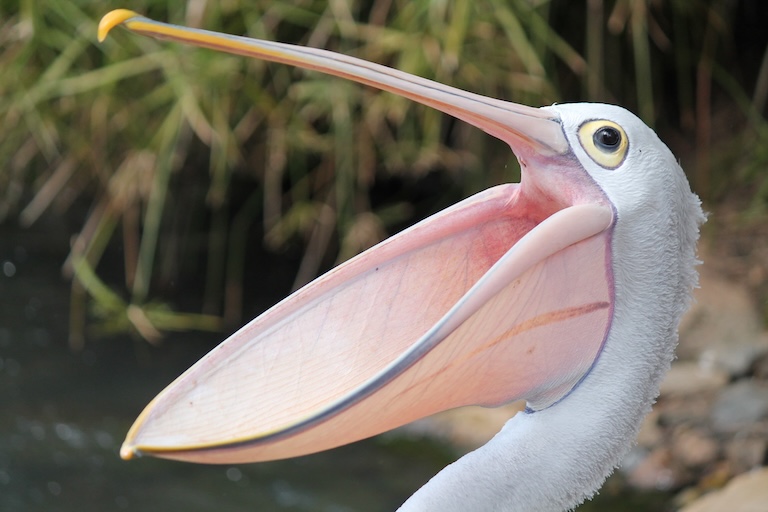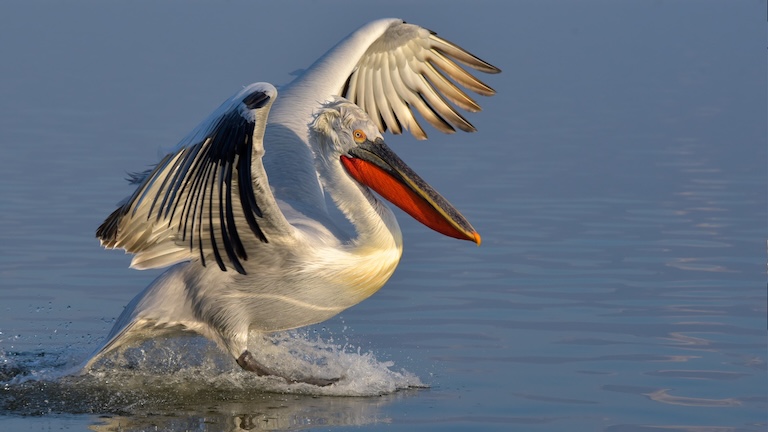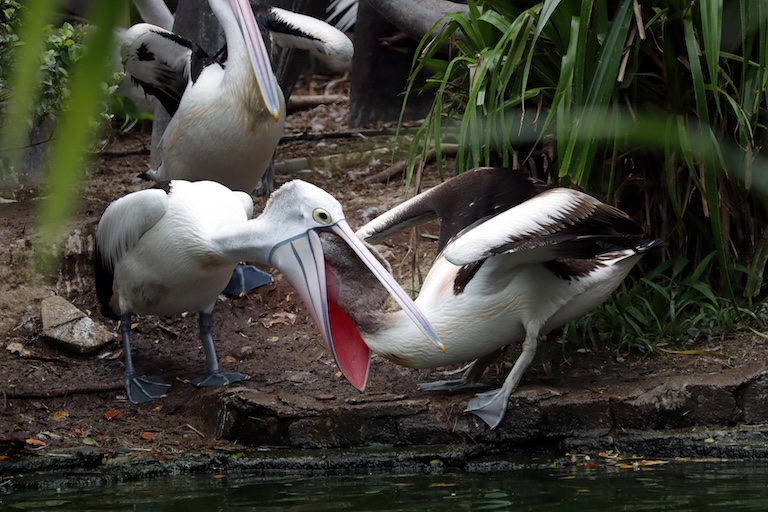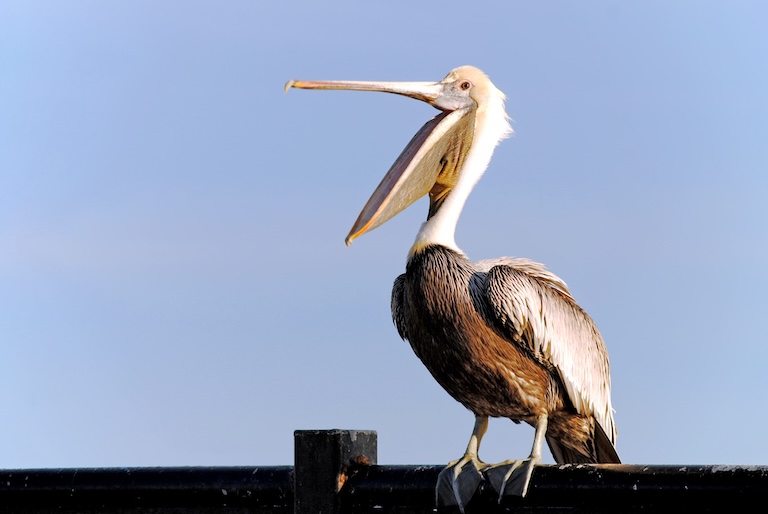Pelican Profile
Pelicans are large, water dwelling birds found across the world in warm and temperate climates. They are seldom far from water, usually only resting and nesting on land. 1
The brown pelican is exclusively a marine bird and almost never ventures inland, preferring the shelter and safety of small islands and sand dunes to lay its eggs. Other species such as the Dalmatian pelican spend the majority of its life inland, preferring the calmer waters of lakes and slow-flowing rivers.
Pelicans are well known for their large throat sac or gular pouch, which expands to hold more than three times the capacity of their stomachs. This makes them extremely efficient fishing birds, allowing the pelican to scoop up large amounts of fish before finding a safe spot to eat.

Due to their large size and the fact that they are also soaring birds, it is necessary for pelicans to catch a large amount of fish each day. 2
Most pelican species are social and often feed in and amongst other pelicans as well as with different species of water bird. Despite their sociable natures, they are relatively quiet birds, only making noise when feeding in groups or greeting other flock members after a day spent fishing. They can however be territorial when breeding and will chase away other pelicans to ensure they have the best nesting spot.
Despite being excellent fliers, pelicans can look clumsy and ungainly on land. Their large bodies and webbed feet have evolved to make them expert swimmers and thus they tend to spend little time on land when not breeding.
Taking off to fly can also be problematic due to their large size. Pelicans have to flap their huge wings to get momentum before running across the surface of the water and using the wind to help them take flight. 3
Pelican Facts Overview
| Habitat: | Rivers, lakes and oceans in warm and temperate climates |
| Location: | Worldwide but never far from water |
| Lifespan: | 25 years in the wild |
| Size: | Wingspan up to 3m long |
| Weight: | 3kg to 12kg |
| Colour/Appearance: | Large waterbird with prominent throat sac. Colours range from white to brown to grey |
| Diet: | Fish but also reptiles, amphibians and crustaceans |
| Predators: | Adults preyed upon by sharks, seas lions and large carnivorous mammals and reptiles |
| Top Speed: | Up to 50km/h |
| Number of Species: | 8 |
| Threats: | Climate change and entanglement in fishing nets and lines |
| Conservation status: | Near Threatened to Least Concern |
Pelicans are comprised of 7 or 8 species and though they share many similarities, each species has its own distinct appearance and behaviours. The largest pelican, the Dalmatian pelican, is one of the largest flying birds in the world. 4

It weighs over 10kg and has a wingspan of over 3 metres. By contrast the smallest pelican, the brown pelican, has a wingspan of less than 2 metres and can weigh less than 3kg. 5
Not all species of pelican catch their food in the same way either. The white pelicans usually hunt their fish in teams, corralling the fish towards the shore before scooping them up with their huge bills. The Dalmatian pelican however usually fishes with other birds such as cormorants, which drive fish closer to the surface where the pelicans can catch them.
The brown pelican uses a completely different technique and dives into the water at great speed, trapping the fish in their gular sacs. They have special air sacs under their skin which help cushion the impact that their body makes with the water surface.
Other species such as the spot-billed pelican, prefer to hunt closer to shore, casually stalking fish before rapidly swimming towards them and picking them off one by one.
Pelican species also differ in how they breed. Different species show colours of pink, red or yellow on the bare patches on their face during the breeding season and most nest in communal colonies. The spot-billed pelicans nest in tree branches, usually several metres above the ground or water.
Most of the other species nest on islands, sand dunes or in swamps or wetlands. The male and female pair both take turns incubating the eggs and then feeding their chicks when they hatch. When the chicks reach around 12 weeks old they leave the nest and become fully independent. 6
Interesting Pelican Facts
1. Pelicans carry more than fish in their throat pouches
Although very useful when fishing, pelicans also use their throat pouches to carry nesting material to their nest sites.

2. They eat more than just fish
Although fish make up the vast majority of their diet, pelicans will also catch and eat frogs, crabs, eggs and even other birds.
3. Pelicans do not keep fish in their gular sacs for long
After scooping up fish, pelicans drain out the water and then proceed to eat the fish straight away, unless it is unsafe to do so.
4. Pelicans can dive bomb to catch fish
Some species, such as the brown and Peruvian pelican, dive headfirst into the water to snap up fish.
5. Most pelicans do not mate for life
Pelicans generally only pair up during the breeding season. The following season they will likely have a different mate.
6. They are some of the biggest and heaviest flying birds
Although other flying birds such as the Kori bustard are heavier, the Dalmatian pelican isn’t far behind.

7. Pelicans are found all over the world
The only continent where pelicans are not found is across Antarctica.
8. White pelicans prefer to hunt together
Hunting in teams makes catching fish easier and the white pelicans are expert in grouping fish together so that all the team members have a fish for their meal.
9. Some pelicans can live to over 50 years
In the wild, pelicans generally live to around 20 years old but in captivity they can survive for up to 54 years.
10. Pelicans are mostly active during the day
Pelicans are diurnal and prefer to do all their fishing during the daylight hours.
11. Some breeding colonies consist of several hundred breeding pelicans
As breeding spots are often small islands, pelicans generally breed in huge numbers in such areas.
12. Pelican chicks have to reach into their parents bills to get their food
Pelican parents simply open their bills wide and the chicks reach in to eat the regurgitated fish. 7
Pelican Fact-File Summary
Scientific Classification
| Kingdom: | Animalia |
| Phylum: | Chordata |
| Class: | Sarcopterygii |
| Order: | Pelecaniformes |
| Family: | Pelecanidae |
| Genus: | Pelecanus |
| Species: | 8 Species |
Fact Sources & References
- “Pelican”, San Diego Zoo.
- (2020), “Australian Pelican”, Australian Museum.
- “Brown Pelican”, The Cornell Lab.
- “Pelecanidae – Pelicans”, Wildlife Journal Junior.
- (1999), “Pelican”, Britannica.
- “Pelican”, National Geographic.
- “Pelecanus-pelicans”, Animal Diversity Web.
